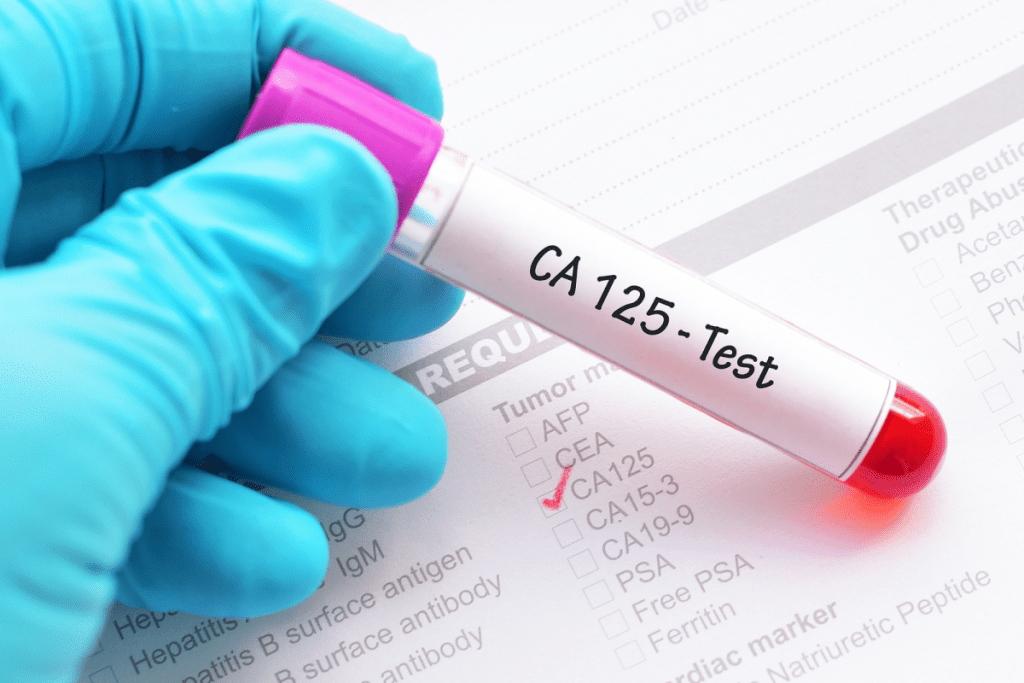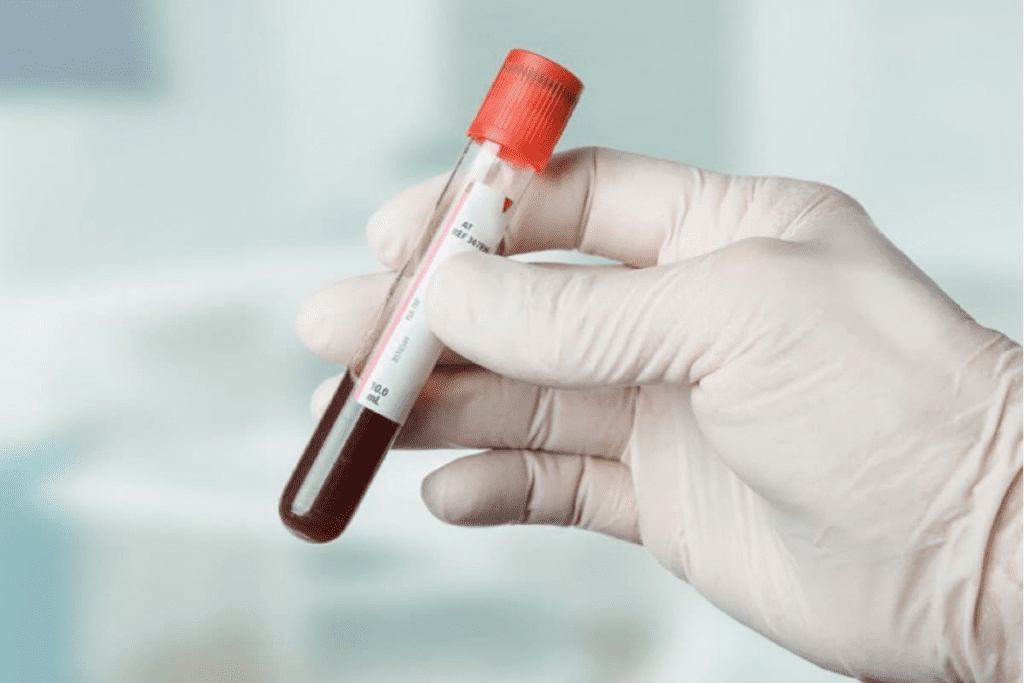Last Updated on November 26, 2025 by Bilal Hasdemir

About 20,890 women will be diagnosed with ovarian cancer this year, says the American Cancer Society. This often happens late in the disease. Blood tests are key in catching it early.
The CA-125 and HE4 blood tests help find ovarian cancer. The CA-125 checks for a protein in the blood. The HE4 looks for a protein that’s high in women with this cancer.
Key Takeaways
- The CA-125 blood test is commonly used to detect ovarian cancer.
- The HE4 blood test is another important diagnostic tool.
- Blood tests play a vital role in early detection.
- Early detection is key for effective treatment.
- The ROMA test is used to assess the risk of ovarian cancer.
The Importance of Early Detection in Ovarian Cancer
Early detection of ovarian cancer is key to better treatment outcomes. Ovarian cancer is often found late, making treatment harder and survival rates lower. Early detection is critical because it allows for timely treatment, when the cancer might be smaller.
Why Ovarian Cancer Is Often Diagnosed Late
Ovarian cancer symptoms are often vague and can be mistaken for other issues. Symptoms include bloating, pelvic pain, and trouble eating. These symptoms are hard to pinpoint, making early diagnosis tough.
Recognizing these symptoms is important for both patients and doctors. There’s no reliable screening test for ovarian cancer in the general population. This highlights the need for better diagnostic tools and awareness about symptoms.
The Role of Laboratory Testing in Diagnosis
Laboratory tests, like blood tests, are vital in diagnosing ovarian cancer. The CA-125 blood test is often used, but it’s not perfect. CA-125 levels can rise in many conditions, not just ovarian cancer. Yet, when combined with imaging and clinical checks, CA-125 testing helps in diagnosis and tracking.
Lab tests do more than diagnose; they help track how well treatment is working and if the cancer comes back. Biomarkers like CA-125 are key in managing ovarian cancer, giving insights into disease progress and treatment response.
Ovarian Cancer Blood Test: An Overview of Available Options

There are many blood tests for ovarian cancer, each with its own role. These tests are key in the fight against this disease. They give doctors important information to help care for patients.
Types of Blood Tests Used in Ovarian Cancer
Several blood tests are used to diagnose and monitor ovarian cancer. The most common is the Cancer Antigen 125 (CA-125) test.
- CA-125: High levels often mean ovarian cancer, but can also be seen in other conditions.
- HE4 (Human Epididymis Protein 4): Used with CA-125 to check ovarian cancer risk.
- ROMA (Risk of Ovarian Malignancy Algorithm): Uses CA-125 and HE4 to rate ovarian cancer risk in women with pelvic masses.
Tumor marker tests are key for tracking how the disease is doing and how well treatment is working. But, it’s important to know their limits to understand the results right.
When Blood Tests Are Ordered by Oncologists
Oncologists order blood tests based on a patient’s risk, symptoms, and treatment progress. These tests help see if treatment is working and if the disease might come back.
Limitations of Routine Blood Tests
Even though blood tests are very helpful, they have some downsides. Not all ovarian cancers show up in these tests, and some non-cancerous conditions can also cause high levels.
| Test | Use | Limitation |
| CA-125 | Monitoring ovarian cancer | Can be elevated in other cancers and conditions |
| HE4 | Assessing ovarian cancer risk | Limited use as a standalone test |
| ROMA | Risk stratification for ovarian cancer | Requires both CA-125 and HE4 results |
It’s important to know these limits to understand blood test results correctly in ovarian cancer diagnosis and treatment.
The CA-125 Blood Test for Ovarian Cancer
The CA-125 blood test is key in diagnosing and tracking ovarian cancer. It shows how the disease is progressing and how well treatments are working. This test looks for Cancer Antigen 125 (CA-125) in the blood, a protein linked to ovarian cancer.
What is Cancer Antigen 125 (CA-125)?
CA-125 is a protein found in the blood of women with ovarian cancer. It’s not only found in ovarian cancer but also in other conditions. Yet, CA-125 is a useful marker for tracking the disease.
Normal vs. Elevated CA-125 Levels
CA-125 levels are usually under 35 U/mL when they’re normal. But, high levels don’t always mean ovarian cancer. Pregnancy, endometriosis, and pelvic inflammatory disease can also raise CA-125. It’s important to check why CA-125 levels are high.
- Normal Levels: Below 35 U/mL
- Elevated Levels: May indicate ovarian cancer or other conditions
Clinical Applications of CA-125 Testing
CA-125 testing is used in several ways:
- Tracking how well ovarian cancer treatment is working
- Finding when ovarian cancer comes back
- Checking if ovarian cancer risk is high in women with a pelvic mass
Even though the CA-125 test is helpful, it has its limits. It can sometimes give false positives. Doctors look at CA-125 results along with other tests and symptoms to make the best decisions.
CA-125 Levels in Different Ovarian Cancer Stages
It’s important to know how CA-125 levels relate to ovarian cancer stages for better management. CA-125 is a protein used as a biomarker for ovarian cancer. It helps track how the disease progresses and how well it responds to treatment.
CA-125 Patterns in Early-Stage Disease
In early ovarian cancer, CA-125 levels might not always be high. This makes it less effective for catching the disease early. But, some stage I ovarian cancer patients might have high CA-125 levels. This could mean cancer is present.
Key points about CA-125 in early-stage ovarian cancer:
- Not all early-stage ovarian cancers have elevated CA-125 levels.
- Elevated CA-125 in early-stage disease may indicate a higher tumor burden or more aggressive disease.
- CA-125 is not used as a standalone diagnostic tool for early-stage ovarian cancer.
CA-125 Patterns in Advanced Disease
CA-125 levels are more often high in advanced ovarian cancer. This makes it a good marker for tracking disease progression and treatment response in advanced cases.
Characteristics of CA-125 in advanced ovarian cancer:
- Higher CA-125 levels are often associated with more extensive disease.
- CA-125 levels can be used to assess how well the cancer is responding to treatment.
- Changes in CA-125 levels over time can provide insights into disease progression or regression.
Monitoring Treatment Response with CA-125

CA-125 levels are key in tracking how well ovarian cancer responds to treatment. A drop in CA-125 levels usually means the treatment is working. But, if levels stay the same or go up, it might mean the cancer is not responding or has come back.
Monitoring treatment response with CA-125 involves:
- Regular blood tests to measure CA-125 levels.
- Correlating changes in CA-125 levels with clinical findings and imaging studies.
- Adjusting treatment plans based on CA-125 trends and other clinical indicators.
Understanding False Positives in CA-125 Testing
It’s important to know the limits of the CA-125 blood test for accurate ovarian cancer diagnosis. The CA-125 test is useful for finding ovarian cancer, but it has its limits. Doctors face challenges in understanding test results, like false positives and borderline results.
Non-Cancerous Conditions That Elevate CA-125
False positives in CA-125 testing can happen for many reasons. These include:
- Endometriosis
- Pregnancy
- Pelvic inflammatory disease
- Uterine fibroids
- Menstruation
These conditions can make CA-125 levels go up, leading to false positives. It’s key for doctors to think about these when looking at test results.
Interpreting Borderline Results
Borderline CA-125 results can be tricky to diagnose. When results are close, more tests or watching the levels might be needed. Knowing how sensitive and specific the CA-125 test is helps a lot.
The test’s sensitivity is about 80% for finding ovarian cancer. But its specificity is lower, mainly in younger women.
| Condition | Effect on CA-125 Levels |
| Endometriosis | May elevate CA-125 levels |
| Pregnancy | Can cause elevated CA-125 levels |
| Pelvic Inflammatory Disease | May result in elevated CA-125 levels |
To understand CA-125 test results, doctors need to know a lot about the patient. This includes their medical history and other test results. By looking at all this, doctors can make better choices about more tests and treatment.
HE4 Blood Test for Ovarian Cancer Detection
The HE4 blood test is a key tool in finding ovarian cancer early. It checks for Human Epididymis Protein 4 (HE4) in the blood. This protein is higher in people with ovarian cancer. Doctors use HE4 to diagnose and treat ovarian cancer better.
Human Epididymis Protein 4 as a Biomarker
HE4 is a protein found more in ovarian cancer cells. The HE4 blood test looks for this protein in the blood. It’s a good marker for ovarian cancer, helping find it early.
Research shows HE4 is more specific for ovarian cancer than other markers. This means it can give more accurate results, reducing false positives.
Comparing HE4 and CA-125 Performance
CA-125 is a known biomarker for ovarian cancer, but it’s not perfect. HE4 is better at finding ovarian cancer early. Together, HE4 and CA-125 make a better test.
The ROMA test uses both HE4 and CA-125. It calculates the risk of ovarian cancer. This gives a clearer picture of a patient’s situation.
Clinical Utility of HE4 Testing
HE4 testing is useful for finding ovarian cancer early. It’s part of the ROMA test. This helps doctors find patients at risk and start the right treatment.
HE4 testing also helps track how well treatment is working. It can spot when cancer comes back. Using HE4 in medicine can lead to better care for patients by catching problems sooner.
The ROMA Test: Combining CA-125 with HE4 for Ovarian Cancer Diagnosis
The Risk of Ovarian Malignancy Algorithm (ROMA) test is a big step forward in finding ovarian cancer. It uses CA-125 and HE4 biomarkers. This test helps doctors better understand the risk of ovarian cancer in women with a pelvic mass.
How the Risk of Ovarian Malignancy Algorithm Works
The ROMA test combines HE4 and CA-125 levels with the patient’s menopausal status. This gives a detailed look at the patient’s condition. It goes beyond what single biomarker tests can do.
The test uses a complex formula to calculate the risk of ovarian cancer. This score helps doctors sort patients into risk groups. This makes it easier to decide on the next steps and treatments.
Risk Stratification Using ROMA Scores
ROMA scores are key in deciding what to do next for patients. They help doctors figure out if a patient is at high or low risk of ovarian cancer. This lets them tailor care to each patient’s needs.
- High Risk: Patients at high risk might need more tests and surgery.
- Low Risk: Patients at low risk might not need surgery and can be watched more closely.
Evidence Supporting ROMA Test Effectiveness
Many studies show the ROMA test is good at finding ovarian cancer. It does better than CA-125 alone because it uses both HE4 and CA-125.
Clinical trials and real-world data back up the ROMA test. They show it can lead to earlier and more accurate diagnoses. This can improve patient outcomes.
OVA1 Test: Multi-Biomarker Approach to Ovarian Cancer Screening
The OVA1 test is a big step forward in finding ovarian cancer early. It uses a multi-biomarker approach. This blood test looks at five different biomarkers to see if you might have ovarian cancer.
The Biomarkers in the OVA1 Panel
The OVA1 test checks five biomarkers: CA-125, transthyretin, apolipoprotein A1, beta-2 microglobulin, and transferrin. Each one is important for figuring out your risk of ovarian cancer.
- CA-125: A well-established marker for ovarian cancer.
- Transthyretin: Helps in assessing the overall health and possible inflammation.
- Apolipoprotein A1: Involved in lipid metabolism, its levels can indicate various health conditions.
- Beta-2 microglobulin: Associated with tumor burden and disease progression.
- Transferrin: Plays a role in iron transport and can be indicative of various physiological and pathological conditions.
Interpreting OVA1 Test Results
The OVA1 test gives a score that shows how likely you are to have ovarian cancer. If your score is high, you might need more tests to check for cancer.
| OVA1 Score | Risk Interpretation | Recommended Action |
| Below Threshold | Lower Risk | Routine Monitoring |
| Above Threshold | Higher Risk | Further Diagnostic Evaluation |
Clinical Applications of OVA1 Testing
The OVA1 test is great for checking women before surgery if they might have ovarian cancer. It helps find who needs to see a gynecologic oncologist for more care.
By looking at many biomarkers, the OVA1 test gives a better idea of ovarian cancer risk. This helps doctors make better choices for their patients.
Tumor Marker Tests for Ovarian Cancer Beyond CA-125
Other tumor markers like CEA, CA19-9, and inhibin are important in fighting ovarian cancer. They help doctors diagnose, track, and understand how the disease grows.
Carcinoembryonic Antigen (CEA)
Carcinoembryonic Antigen (CEA) is often linked to colorectal cancer but can also show up in ovarian cancer. It’s not specific to ovarian cancer but can help track how the disease is doing and how well treatments work.
Cancer Antigen 19-9 (CA19-9)
Cancer Antigen 19-9 (CA19-9) is mainly linked to pancreatic cancer but can also be found in ovarian cancer, mostly in mucinous types. It’s used to help diagnose and keep an eye on ovarian cancer.
Inhibin and Other Emerging Markers
Inhibin is a protein complex being studied as a marker for ovarian cancer, mainly for certain types like granulosa cell tumors. Other new markers are being looked into for better ovarian cancer detection and care. These include proteins and genetic markers that could improve disease detection and tracking.
Using these tumor markers, along with CA-125, shows how complex and detailed ovarian cancer diagnosis and treatment can be. Knowing how each marker works helps doctors give more precise diagnoses and treatment plans.
Genetic Blood Tests for BRCA Mutations and Ovarian Cancer Risk
There’s a strong link between BRCA mutations and ovarian cancer risk. Genetic blood tests help figure out this risk. These tests are useful for people with a family history of ovarian or breast cancer. They look for mutations in the BRCA1 and BRCA2 genes.
BRCA1 and BRCA2 Testing Methods
Testing for BRCA1 and BRCA2 mutations involves a blood test. This test checks the DNA in the blood for harmful mutations. It’s a simple process, and results usually come back in a few weeks.
Key aspects of BRCA1 and BRCA2 testing include:
- Identifying harmful mutations that increase cancer risk
- Analyzing the DNA in blood samples
- Providing results that can inform preventive measures
Interpreting Genetic Test Results
Understanding BRCA1 and BRCA2 test results needs expertise. A positive result means a harmful mutation is present, raising cancer risk. A negative result doesn’t mean no cancer risk, as other factors also matter.
“Genetic testing for BRCA mutations has become an essential tool in the management of ovarian cancer risk, particular for individuals with a significant family history of the disease.”
” Expert in Genetic Oncology
Implications for Family Members
Discovering a BRCA mutation affects not just the individual but their family too. Relatives might also carry the mutation, making genetic counseling and testing vital.
Family members may consider:
- Genetic counseling to understand their risk
- Testing for the specific BRCA mutation identified in their relative
- Discussing preventive measures with their healthcare provider
Knowing their genetic risk helps individuals make health decisions. This might include preventive surgeries or closer cancer monitoring.
Blood Test Accuracy in Ovarian Cancer Detection
It’s key to know how accurate blood tests are for finding ovarian cancer. These tests are important for spotting the disease. But, their accuracy can change based on many things.
Understanding Sensitivity and Specificity
The sensitivity and specificity of a blood test matter a lot. Sensitivity means the test can find most people with ovarian cancer. Specificity means it can also correctly say who doesn’t have it.
- Sensitivity: A good test finds most cases of ovarian cancer, avoiding false negatives.
- Specificity: A good test also correctly says who doesn’t have ovarian cancer, avoiding false positives.
It’s important to find a balance between sensitivity and specificity. A test that’s too sensitive but not specific can cause worry and extra tests for no reason.
Comparative Accuracy of Different Biomarkers
Not all biomarkers are the same when it comes to finding ovarian cancer. CA-125 is often used, but HE4 and the ROMA test are also promising.
| Biomarker | Sensitivity | Specificity |
| CA-125 | High | Moderate |
| HE4 | Moderate | High |
| ROMA Test | High | High |
Factors Affecting Test Reliability
Several things can make blood tests less reliable for finding ovarian cancer. These include:
- Biomarker variability: Different biomarkers work better or worse.
- Stage of cancer: It’s harder to find early-stage ovarian cancer.
- Individual health factors: Some health issues can mess with biomarker levels, leading to wrong results.
Knowing these factors helps us understand blood test results better. It helps us make smart choices about what to do next.
Monitoring Ovarian Cancer Recurrence with Blood Tests
It’s key to watch for ovarian cancer coming back after treatment. Patients need regular checks to catch any signs early.
Post-Treatment Surveillance Protocols
After treatment, patients go through a series of checks. These include physical exams, imaging, and blood tests. How often and for how long depends on the patient’s risk and treatment history.
For those with ovarian cancer, CA-125 blood tests are a common tool. They check for cancer antigen 125 in the blood, a sign of ovarian cancer.
Interpreting Rising Biomarker Levels After Remission
If CA-125 levels go up after treatment, it might mean the cancer is back. But, other things like harmless conditions or lab errors can also raise levels.
A rising trend in CA-125 is more telling than a single high reading. Doctors look at this trend to decide what to do next. This might include more tests or biopsies to confirm if the cancer has returned.
Keeping a close eye on recurrence can lead to better treatment and a better life for ovarian cancer patients.
Liquid Biopsy and Advanced Blood-Based Detection Methods
Ovarian cancer detection is getting better thanks to liquid biopsy. This method checks the blood for tumor parts. It’s seen as a great way to find cancer early and keep track of it.
Circulating Tumor DNA Analysis
Circulating tumor DNA (ctDNA) analysis is a big part of liquid biopsy. It looks for DNA bits from tumors in the blood. This helps find specific genetic changes linked to ovarian cancer, leading to early diagnosis and tailored treatments.
Looking at ctDNA can tell doctors a lot about the tumor. It shows how the disease is growing and how well treatments are working. Research shows that ctDNA levels can show how big the tumor is and how well a patient will do.
Circulating Tumor Cells Detection
Circulating tumor cells (CTCs) are also key in finding ovarian cancer. These cells come from the main tumor and travel in the blood. They can start new tumors. Finding and studying CTCs gives clues about the tumor and can predict when cancer might come back.
Studies have found that more CTCs mean worse outcomes for ovarian cancer patients. Watching CTCs can also help see how well treatments are working and find ways cancer might resist treatment.
MicroRNA Profiling in Blood Samples
MicroRNAs (miRNAs) are small RNA molecules that control gene activity. Research has found that certain miRNA patterns in blood can help spot ovarian cancer. miRNA profiling looks at how different miRNAs are expressed to find cancer-linked patterns.
Using miRNA profiling for ovarian cancer is just starting, but it could make finding cancer more accurate. More research is needed to make sure it works well in real-world settings.
New FDA-Approved Blood Tests for Ovarian Cancer (2023-2025)
The field of ovarian cancer detection is changing with new blood tests approved by the FDA from 2023 to 2025. These tests are key for early detection and managing ovarian cancer. This disease is often found late because its symptoms are not clear.
Recently Approved Diagnostic Tests
The FDA has approved several blood tests for ovarian cancer in recent years. The ROMA (Risk of Ovarian Malignancy Algorithm) test combines HE4 and CA-125 results. It helps figure out the risk of ovarian cancer in women with a pelvic mass.
A study in the Journal of Clinical Oncology found the ROMA test to be very accurate. It has high sensitivity and specificity in detecting ovarian cancer.
The OVA1 test is another important approval. It measures five proteins to see if ovarian cancer is likely in women with a pelvic mass. The OVA1 test helps find women at high risk of ovarian cancer early.
Promising Tests in Clinical Trials
There are also blood tests in clinical trials that are not yet approved. These include tests for circulating tumor DNA (ctDNA) and circulating tumor cells (CTCs). They show promise in finding ovarian cancer early.
A study at the American Society of Clinical Oncology (ASCO) Annual Meeting showed a new ctDNA-based test’s effectiveness. It was very accurate, making it a promising diagnostic tool for the future.
As research goes on, we’ll see more new blood tests for ovarian cancer. The trials are important for proving these tests work. They will help get these tests approved and used in clinics.
Conclusion: The Future of Blood Testing in Ovarian Cancer Care
The way we diagnose and monitor ovarian cancer is changing fast. Blood tests are becoming more important. New biomarkers and testing technologies are making these tests more accurate and useful.
Research is finding new biomarkers and improving tests. This means blood tests will help find ovarian cancer early and track treatment better. Tests like CA-125, HE4, and multi-biomarker panels are already helping doctors.
The future of blood testing in ovarian cancer looks bright. We’ll see more personalized and precise tests. New technologies like liquid biopsy and advanced genomic analysis will help patients even more. Blood testing will keep being a key part of diagnosing, monitoring, and assessing risk in ovarian cancer care.
FAQ
What is the most common blood test used for ovarian cancer?
The CA-125 blood test is most often used for ovarian cancer. It checks the level of cancer antigen 125 in the blood. This can be high in women with ovarian cancer.
How accurate is the CA-125 blood test in detecting ovarian cancer?
The CA-125 test isn’t perfect and can give false positives. But, it’s useful when combined with other tests like imaging and physical exams. It helps detect ovarian cancer.
What is the ROMA test, and how is it used in ovarian cancer diagnosis?
The ROMA test combines CA-125 and HE4 levels to assess ovarian cancer risk. It helps sort patients into risk categories. This guides further management.
What is the OVA1 test, and how is it used in ovarian cancer screening?
The OVA1 test measures five proteins in the blood to check ovarian cancer risk. It helps identify high-risk women. This guides further evaluation.
Can genetic blood tests detect BRCA mutations and ovarian cancer risk?
Yes, genetic blood tests can find BRCA1 and BRCA2 mutations. These are linked to higher ovarian cancer risk. These tests help identify those who need more surveillance or preventive steps.
How are blood tests used in monitoring ovarian cancer recurrence?
Blood tests, like CA-125, track ovarian cancer recurrence after treatment. Rising levels can signal recurrence. Regular testing helps catch recurrence early.
What are some of the new advancements in blood-based detection methods for ovarian cancer?
New methods include liquid biopsy, circulating tumor DNA analysis, and microRNA profiling. These are being researched to improve detection and diagnosis of ovarian cancer.
Are there any new FDA-approved blood tests for ovarian cancer?
Yes, new FDA-approved blood tests for ovarian cancer have been introduced. These aim to enhance detection and diagnosis. Some are already in use in clinical settings.
How do blood tests compare in terms of accuracy for ovarian cancer detection?
Different blood tests have different accuracy levels for ovarian cancer detection. CA-125 is common but can be wrong sometimes. Tests like HE4 and OVA1 are more accurate in certain cases.
Can blood tests detect ovarian cancer at an early stage?
Blood tests, such as CA-125 and HE4, can spot ovarian cancer early in some cases. But, their accuracy depends on the cancer’s stage and type.
References
- Moore, R. G., Miller, M. C., Disilvestro, P. A., Landrum, L. M., Gajewski, W., Ball, J., & Bast, R. C. Jr. (2020). Evaluation of the diagnostic accuracy of the Risk of Ovarian Malignancy Algorithm using the novel biomarkers HE4 and CA125. Gynecologic Oncology, 119(2), 244-250. https://www.ncbi.nlm.nih.gov/pmc/articles/PMC2826977/






